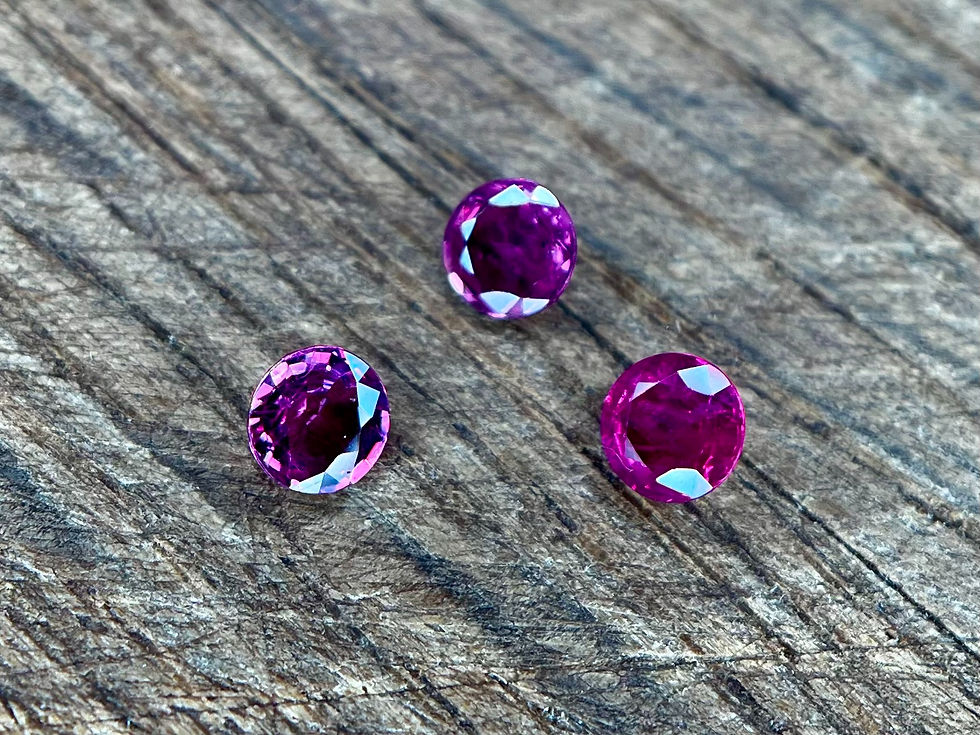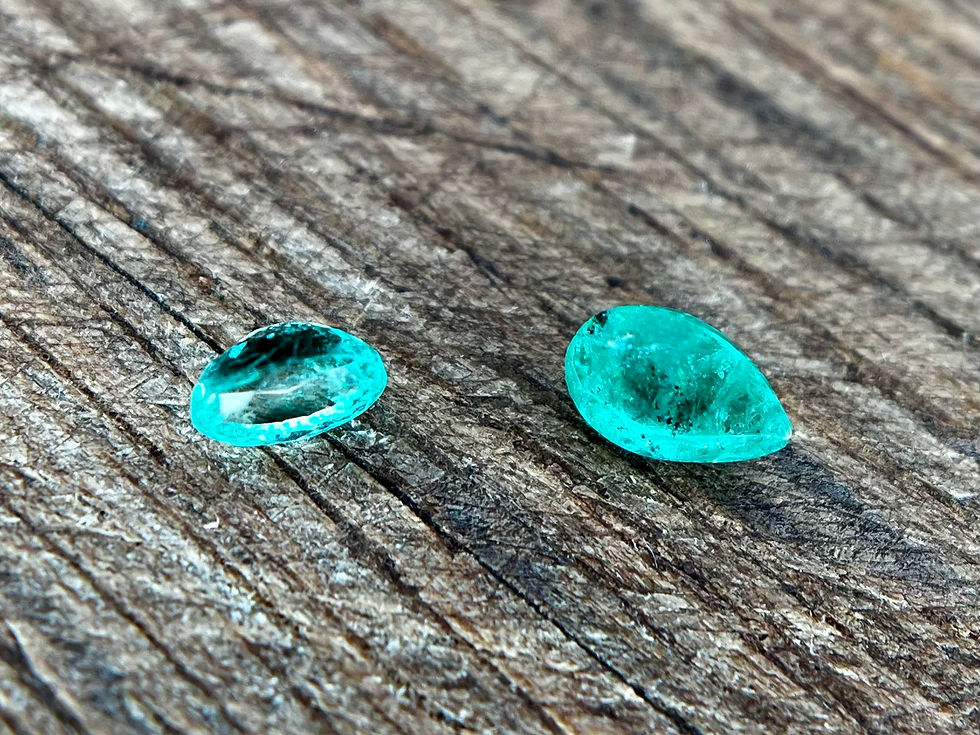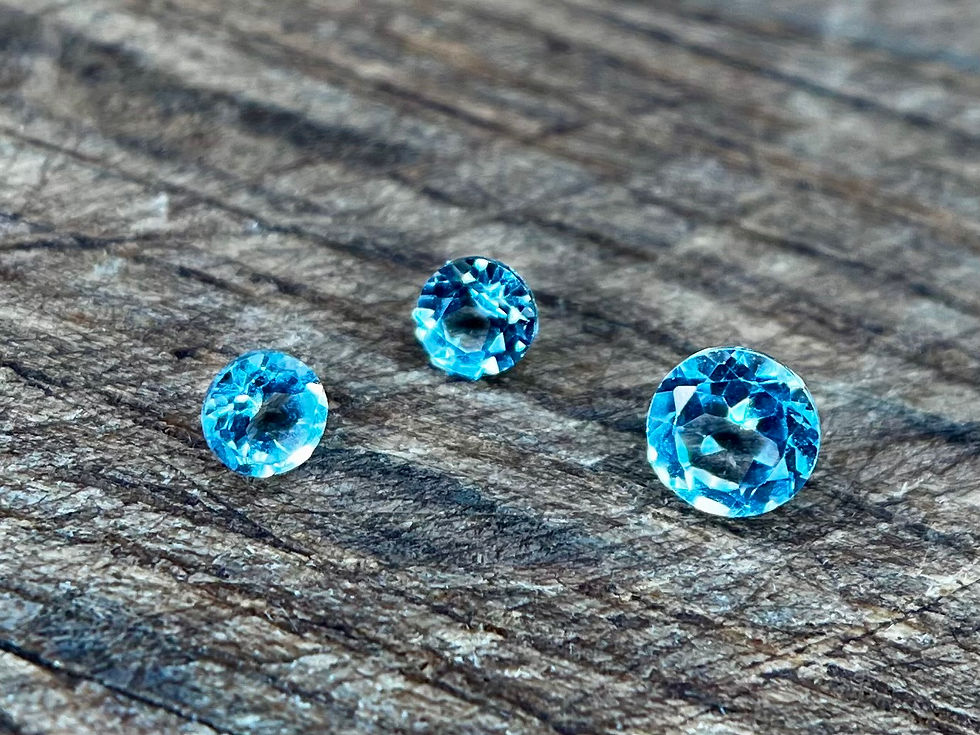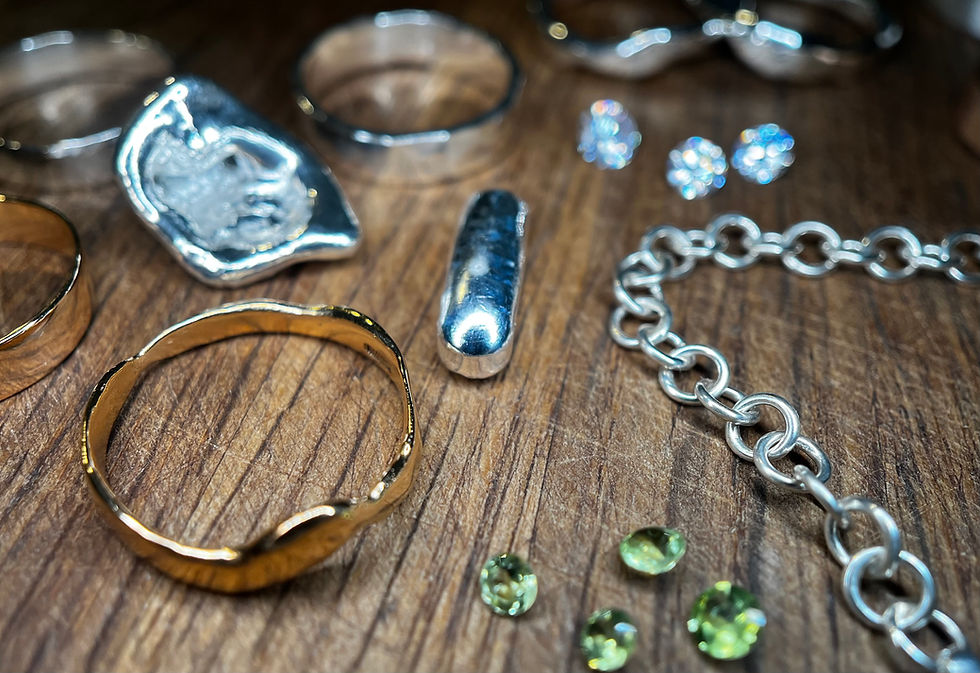Different Types of Gemstone
- Wilson's Precious Metals

- Aug 23
- 5 min read
Updated: Sep 1
Introduction:
At Wilson's we have a number of different options when it comes to the choice of gemstone you can have in your piece of jewellery. We only use natural gemstones in our jewellery with the exception of Lab Grown Diamonds. Any jewellery we make that includes GIA, GCS, or IGI certified gemstones will have the gemstones certificate included with your order.
Ruby:
Ruby is a variety of the mineral corundum, distinguished by its rich red colour caused by trace amounts of chromium. It ranks 9 on the Mohs hardness scale, making it highly durable. Rubies are traditionally sourced from Myanmar, Thailand, and Mozambique, and are valued for their rarity and vivid saturation.
Rubies are prized for their deep red hue, symbolizing passion, vitality, and protection. As one of the hardest gemstones after diamond, they’re ideal for everyday wear. Historically associated with royalty and courage, rubies are often set in statement pieces that evoke timeless elegance.

Emerald:
Emerald is a green variety of beryl, coloured by chromium and vanadium. It typically contains inclusions known as “jardin,” which are accepted as part of its natural character. With a Mohs hardness of 7.5–8, emeralds require careful handling. Colombia remains the most renowned source for high-quality emeralds. Revered since antiquity as a symbol of rebirth and wisdom, emeralds require gentle care due to their relative softness and internal fractures.

Sapphire:
Sapphire is another form of corundum, occurring in a wide range of colours except red (which is classified as ruby). Blue sapphires are the most iconic, often sourced from Sri Lanka, Kashmir, and Madagascar. With a hardness of 9, sapphires are suitable for daily wear and prized for their brilliance and durability. Blue sapphires, in particular, carry regal associations and timeless charm.

Peridot:
Peridot is the gem-quality variety of the mineral olivine, known for its distinctive yellow-green hue. It forms deep within the Earth and occasionally arrives via meteorites. With a Mohs hardness of 6.5–7, it is moderately durable. Major sources include Arizona (USA), Pakistan, and China. Formed deep within the Earth’s mantle, it’s one of the few gemstones that occurs in only one colour. Its cheerful tone makes it a popular choice for summer-inspired designs.

Labradorite:
Labradorite is a feldspar mineral famous for its iridescent optical effect called labradorescence, displaying flashes of blue, green, and gold. It has a Mohs hardness of 6–6.5 and is commonly found in Canada, Madagascar, and Finland. Though not traditionally classified as a precious gem, it is widely used in artistic and metaphysical jewellery. Often associated with intuition and transformation, it’s a favourite among those drawn to mystical aesthetics. Though not as hard as other gems, its visual impact is unmatched.

Amethyst:
Amethyst is a purple variety of quartz, coloured by iron and natural irradiation. It ranks 7 on the Mohs scale and is widely available, making it both affordable and durable. Brazil and Zambia are leading sources. Historically, it was considered as valuable as ruby or emerald before large deposits were discovered. As a variety of quartz, it’s both affordable and durable, making it a staple in both fine and fashion jewellery. Its soothing energy is said to promote balance and inner peace.

Garnet:
Garnet refers to a group of silicate minerals that occur in a range of colours, though red is most common. It has a hardness of 6.5–7.5 and is found globally, with notable sources in India, Sri Lanka, and Africa. Garnets are often used in vintage and antique jewellery due to their rich tones and affordability. Traditionally seen as a stone of commitment and strength, garnet’s rich tones lend warmth and depth to vintage and modern designs alike.

Topaz:
Topaz is a durable gemstone known for its vibrant colors, especially blue, yellow, and the rare reddish-orange of Imperial Topaz. With a hardness of 8 on the Mohs scale, it's ideal for everyday wear. Most blue topaz is treated to enhance its color, and the stone has long been linked to protection and good fortune.

Agate:
Agate is a banded form of chalcedony, a microcrystalline variety of quartz. It forms in volcanic rocks and is known for its layered appearance and wide colour range. With a hardness of 6.5–7, it is durable and often used in carvings, beads, and decorative items. Brazil and Uruguay are major producers. Often used in bohemian and artisanal jewellery, it’s believed to offer grounding and stability. Its durability and affordability make it a versatile design element.

Lapis Lazuli:
Lapis lazuli is a metamorphic rock composed mainly of lazurite, with calcite and pyrite inclusions. Its deep blue colour has been prized since antiquity, especially in ancient Egypt. It has a Mohs hardness of 5–5.5 and is primarily sourced from Afghanistan, Chile, and Russia. Treasured since ancient Egypt, it symbolizes wisdom and truth. Though relatively soft, lapis is best suited for pendants and earrings where it can shine without excessive wear.
Natural Amber:
Amber is fossilized tree resin, not a mineral, and is typically golden to honey-brown in colour. It has a low hardness of 2–2.5 and is lightweight, making it suitable for large jewellery pieces. Baltic amber is the most famous, often containing prehistoric inclusions like insects or plant matter. Its golden glow and lightweight feel make it ideal for large, sculptural pieces. Amber is cherished for its organic origin and calming energy.

Opal:
Opal is a hydrated silica mineral known for its play-of-colour, caused by the diffraction of light through its internal structure. It has a Mohs hardness of 5.5–6.5 and is sensitive to heat and moisture. Australia produces over 90% of the world’s opals, including black, white, and boulder varieties. Associated with creativity and spontaneity, opals require careful handling due to their softness and sensitivity to moisture and temperature changes.

Moonstone:
Moonstone is a feldspar mineral exhibiting adularescence—a soft glow that appears to move across the surface. It has a hardness of 6–6.5 and is commonly found in Sri Lanka, India, and Madagascar. Moonstone is often used in bohemian and spiritual jewellery due to its ethereal appearance. Often linked to intuition and feminine energy, it’s a favourite in romantic and spiritual jewellery. Though delicate, its dreamy appearance makes it a standout in subtle designs.

Diamonds:
Diamond is a crystalline form of carbon and the hardest known natural substance, ranking 10 on the Mohs scale. It is valued for its brilliance and durability. Most diamonds are mined in Russia, Botswana, and Canada, and they are graded based on the 4Cs: cut, colour, clarity, and carat weight.
In recent years ‘Lab Grown Diamonds’ have grown hugely in popularity and now make up a large proportion of newly crafted jewellery. Lab Grown Diamonds have proven to be very popular due to their lower price despite being nearly identical to Natural Diamonds.
Diamonds are the epitome of brilliance and durability, symbolizing eternal love and strength. Their unmatched hardness makes them ideal for daily wear, especially in engagement rings. Available in a range of cuts and colours, diamonds remain the cornerstone of fine jewellery. All diamonds used by Wilson’s Precious Metals come with a Conflict-Free Guarantee Certificate when received from our suppliers, we keep this certificate on file.






Comments